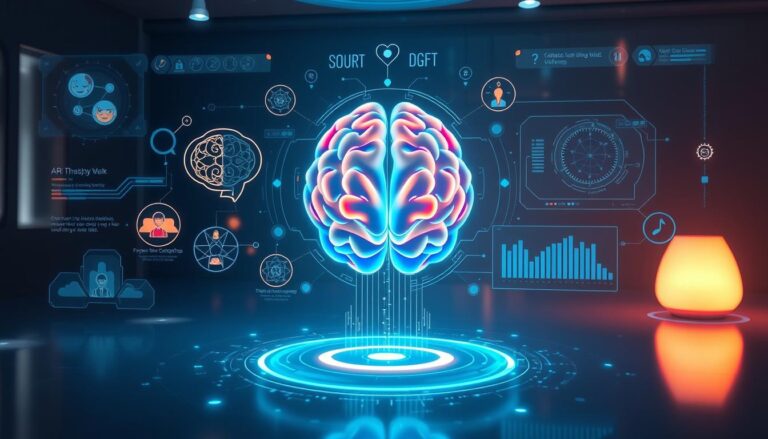Did you know the AI in education sector is expected to hit USD 20.54 billion by 2027? This shows how fast AI is changing schools worldwide. It’s making learning more personal by matching it to each student’s needs.
AI also helps teachers with boring tasks, so they can focus on teaching. New tools like smart tutoring systems and adaptive learning are coming. They promise to change learning forever, making it more fun and engaging. For more on this, check out here1.
Key Takeaways
- AI in education is forecasted to continue growing, integrating with various technologies.
- Adaptive learning systems enhance personalized learning, crucial for improved educational outcomes.
- AI offers administrative assistance, freeing educators to focus on teaching.
- New technologies like AR and VR are being combined with AI to enhance learning experiences.
- The future of AI in education promises significant advancements in learning management systems.
Understanding AI in Education
Artificial Intelligence (AI) in education means using machines to do tasks that humans usually do. AI helps solve problems, make decisions, and learn in ways that fit each student. It makes learning more fun and interactive.
Definition of AI in the Educational Context
In schools, AI is a big help. It gives teachers insights into how students are doing. For example, in California, a game teaches high schoolers about AI and thinking skills2. Another project in California teaches kids and families about AI with a virtual AI helper2.
Key Technologies Behind AI
AI in education relies on technologies like natural language processing and computer vision. AI tutoring systems help students in tough subjects by explaining things and checking their understanding3. AI also makes learning personal by adjusting to each student’s pace and abilities3. Even tools like Microsoft PowerPoint use AI to improve graphic design, showing how AI is used in creative learning3.
The Role of Machine Learning in Schools
Machine learning in schools is changing how we learn. It moves away from the old way of teaching everyone the same thing. Now, it uses data to give each student a learning plan that fits them best.
This change helps teachers make lessons that really grab students’ attention. It makes learning more effective and fun.
Machine Learning Vs. Traditional Learning Methods
Machine learning is different from old teaching methods. It uses special algorithms to look at lots of data about how students do and behave. This helps teachers see what each student needs to get better.
Machine learning can predict problems and help keep students from dropping out. It’s already making schools better at helping students succeed4.
Adaptive Learning Systems
Adaptive learning systems are key to making learning personal. They change what and how students learn based on how they’re doing. This way, everyone gets what they need, no matter how they learn best.
Studies show that these systems really work. They make learning more fun and keep students interested5. Schools are using these tools to help students do better and make the school better too.
| Feature | Machine Learning | Traditional Learning |
|---|---|---|
| Learning Approach | Customized to individual progress and needs | Standardized for all students |
| Data Utilization | Analyzes real-time data for insights | Limited data use; mainly historical |
| Predictive Analysis | Forecasts outcomes and identifies at-risk students | Little to no predictive analysis |
| Learning Environment | Dynamic and responsive to changes | Static, with fixed structures |
By using machine learning, schools can keep up with today’s needs. It makes teaching and learning better for everyone.
Benefits of AI and Machine Learning in Classrooms
AI and machine learning bring many benefits to schools. They make learning more fun and supportive. This is because they offer personalized learning that meets each student’s needs.
Personalized Learning Experiences
AI helps make learning personal. It tailors lessons to what each student is good at and needs to work on. This leads to better results.
Thanks to educational data mining, teachers can keep track of how students are doing. This means each student gets feedback that fits their learning style. It makes learning more engaging and helps them remember things better.
The AI in education market was worth USD 1.82 billion in 2021. It’s expected to grow by 36.0% by 20306. This shows more schools are moving towards personalized learning.
Improved Administrative Efficiency
AI makes school work easier for teachers. It handles things like grading and feedback. This lets teachers focus on teaching and helping students one-on-one.
By doing routine tasks, schools can work more efficiently. This leads to better learning outcomes. Schools using these tools could see a big increase in the online education market, reaching $166.60 billion by 20237.
Enhanced Student Engagement
AI and machine learning make learning more fun. They use tools like chatbots and virtual assistants. These tools help students with their questions and make learning more interactive8.
Students can explore educational materials in new ways. This helps them solve problems and enjoy learning. It makes learning more enjoyable and relevant to their lives.
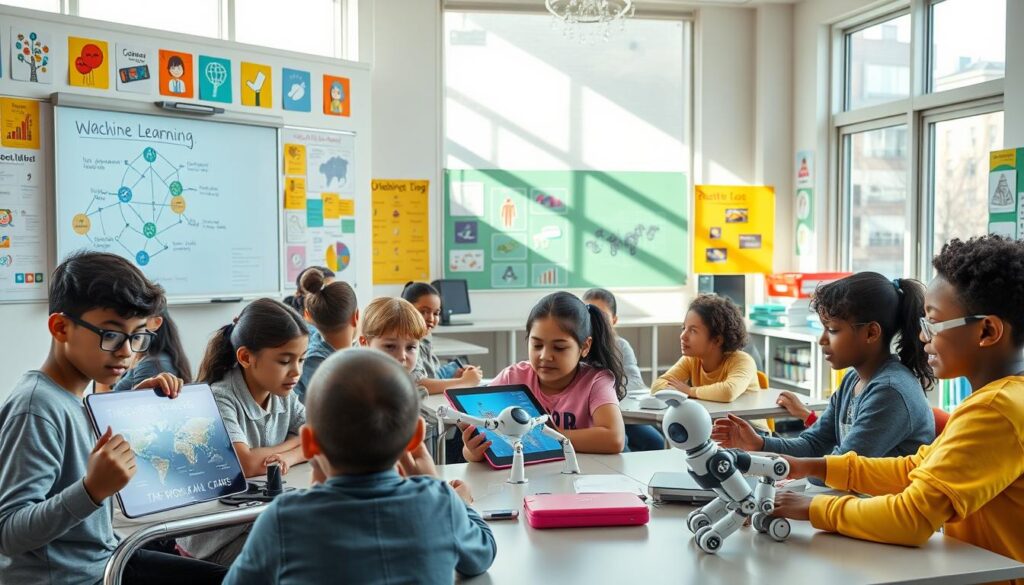
Challenges of Implementing AI in Education
Introducing artificial intelligence (AI) in schools comes with big hurdles. Schools must make sure AI tools work well and are fair. The biggest worry is data privacy in education. Schools need to handle student data carefully and follow rules.
AI can look at personal data and shape learning plans. This raises big questions about keeping student info safe.
Data Privacy Concerns
As AI becomes more common in schools, privacy worries grow. AI needs lots of data to work right. This raises questions about following privacy laws and keeping data safe.
If data isn’t protected well, students might lose trust. This could make learning harder.
Resistance from Educators and Administrators
Many teachers and school leaders are hesitant about AI. They worry AI might replace them. This makes some people skeptical.
Teachers are unsure if AI can really help students. They worry it might not understand each student’s needs, especially in classes with different abilities.
Technological Limitations
Finally, there are tech challenges. Schools without the right tech can’t use AI well. Teachers need training to use AI tools right.
To solve these challenges in education technology, schools and tech makers must work together. They need to make AI tools easy to use.
To get the most from AI, schools must talk about ethics and tech. They need to make sure teachers and students are ready for AI’s future.
It’s crucial to have good training and support. This will help teachers deal with AI’s changes.
Starting programs for teacher growth can help. This way, educators can keep up with AI’s changes.
Overcoming these challenges is key to using AI to improve learning for students910.
Real-World Applications of AI in Schools
AI is changing education in big ways. It’s making learning more personal and teaching more effective. Tools like intelligent tutoring systems are key to this change.
Intelligent Tutoring Systems
Intelligent tutoring systems give students the attention they need. Thinkster Math uses AI to make learning plans for each student. This helps them understand and remember complex topics better11.
AI tools like Jill Watson help students by answering questions and guiding them. Cognii’s virtual learning assistants also adapt to students’ needs, making learning more engaging11.
AI-Driven Assessment Tools
AI is making grading and feedback faster and easier. This lets teachers focus more on teaching. AI tools provide real-time feedback and help track student progress12.
Tools like Nuance make it easier for students to communicate. Presentation Translator adds subtitles live, helping students who struggle with language12.
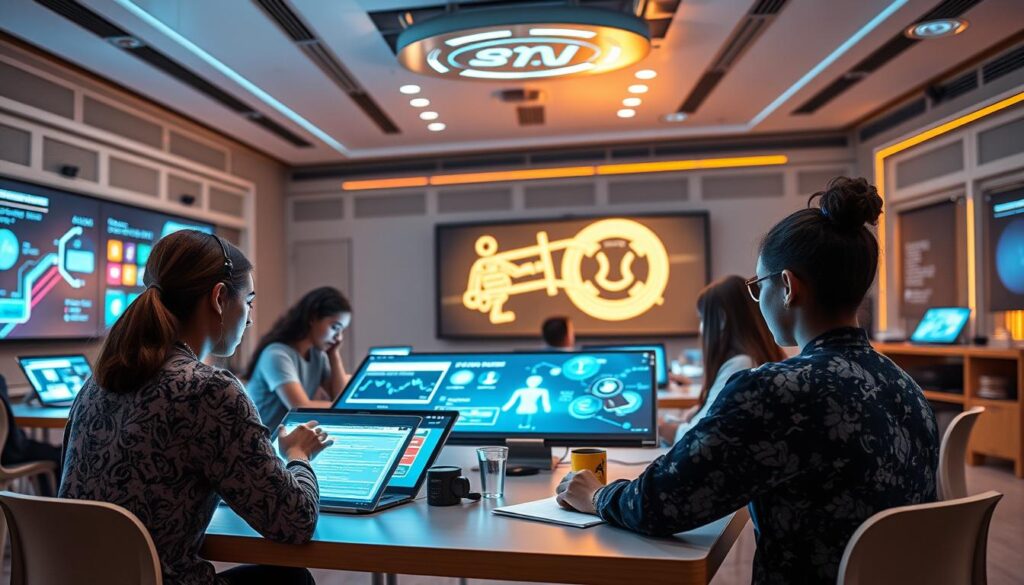
Teachers are starting to see the benefits of AI in schools. Over 50% of U.S. teachers think AI helps teaching and learning13. AI tools are making learning more engaging and effective. The future of education looks bright with AI leading the way13.
The Future of Education Technology
Education technology is changing fast, thanks to innovations in AI. Soon, virtual reality (VR) and augmented reality (AR) will change classrooms. They will make learning fun and real.
This change is not just about using technology. It’s about making learning better for everyone. It’s about learning in a way that fits each person’s needs.
Innovations on the Horizon
AI can now understand how students learn. This means teachers can make learning plans that really work. The World Economic Forum says AI will create 97 million new jobs by 202514.
AI can also make tests that fit each student’s level. This means students get feedback right away and can learn more. Only 27 states in the U.S. have rules for using AI in schools15.
For more info, check out this article.
The Potential of AI to Transform Learning Environments
AI can really change how we learn. Schools like Carnegie Learning and Microsoft are using AI to help students learn better14. Dr. Aleigha Henderson-Rosser says AI can help if teachers use it right16.
This mix of AI and teachers can make learning fun and keep students interested. Experts agree on this16.
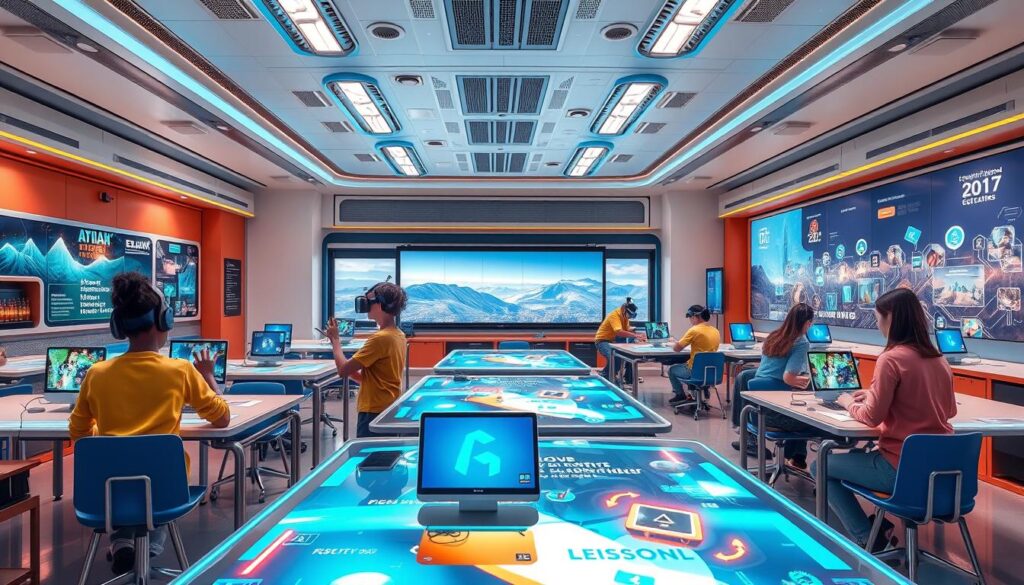
| AI Innovations | Potential Impact |
|---|---|
| Personalized Learning Plans | Enhances retention and comprehension |
| Adaptive Assessments | Reduces exam anxiety and offers immediate feedback |
| Immersive Learning Experiences | Engages students through VR and AR technologies |
| Job Creation in AI Fields | Prepares students for future job markets |
By using innovations in AI, education can become more fun and personal. It will be better for all students151416.
Training Educators to Use AI Effectively
It’s key to teach educators how to use AI tools well in their classrooms. The way we train teachers needs to change to help them with AI. We must create programs that help teachers understand and use AI in their teaching.
Programs for Professional Development
Professional development programs for AI in education should be made for each teacher’s needs. Over the last five years, there’s been a push to bring AI into classrooms. Yet, many teachers say they lack learning chances and aren’t sure how to learn about AI17.
Good programs should give teachers deep, personal learning chances. They should start with the basics, give time for exploration, and create spaces for teamwork17.
Building Digital Literacy Among Teachers
It’s crucial for teachers to be digitally literate to use AI tools confidently. AI literacy should be taught at all levels and subjects. This will help teachers understand AI well18.
Teachers can keep up with AI through many ways, like online courses and webinars. Groups like ISTE, AI4ALL, and Microsoft have courses to improve digital and AI skills17. Online communities and social media groups are great for teachers to talk about AI and new tech. This helps create a space for ongoing learning and growth in the classroom.
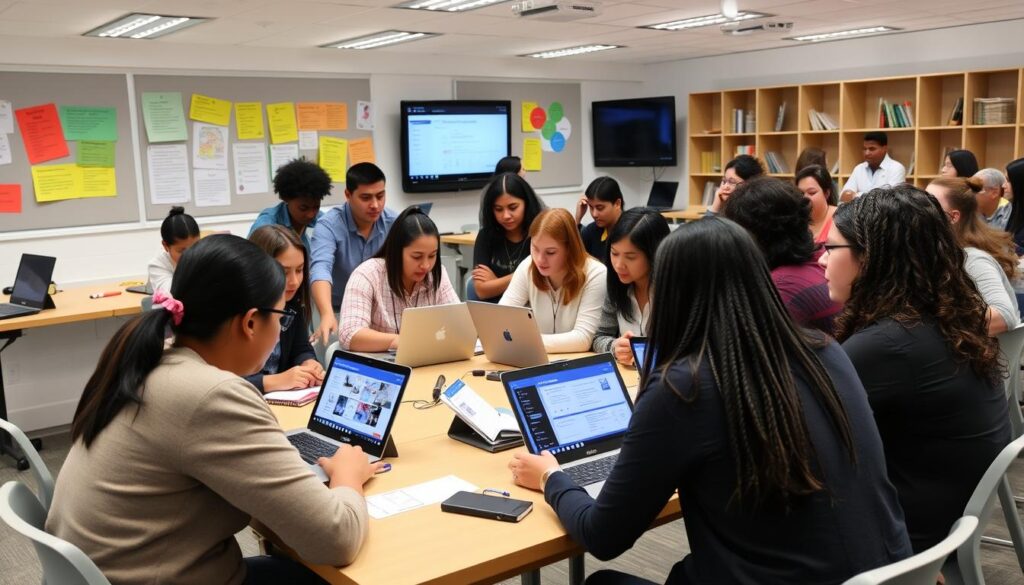
Measuring the Impact of AI on Student Outcomes
It’s key to understand how AI affects student outcomes in education. Teachers and others need to look at specific numbers. These numbers show how AI changes learning and boosts student success.
Metrics for Success
When checking if AI works, we must look at different numbers. These numbers show how well students learn and how interested they are. AI makes learning personal by adjusting to each student’s needs19.
It also makes students more motivated and involved, which helps them do well20. AI helps give fair and accurate tests, helping all kinds of learners20.
Case Studies and Real-World Examples
Real-life examples show how AI changes education. For example, AI tutors help students do better, especially those who struggle21. Schools using AI see better results and teachers work more efficiently19.
AI helps teachers know how students are doing and feel, making education more personal20. Even though some worry about cheating and AI replacing teachers, it mostly helps teachers focus on teaching21.
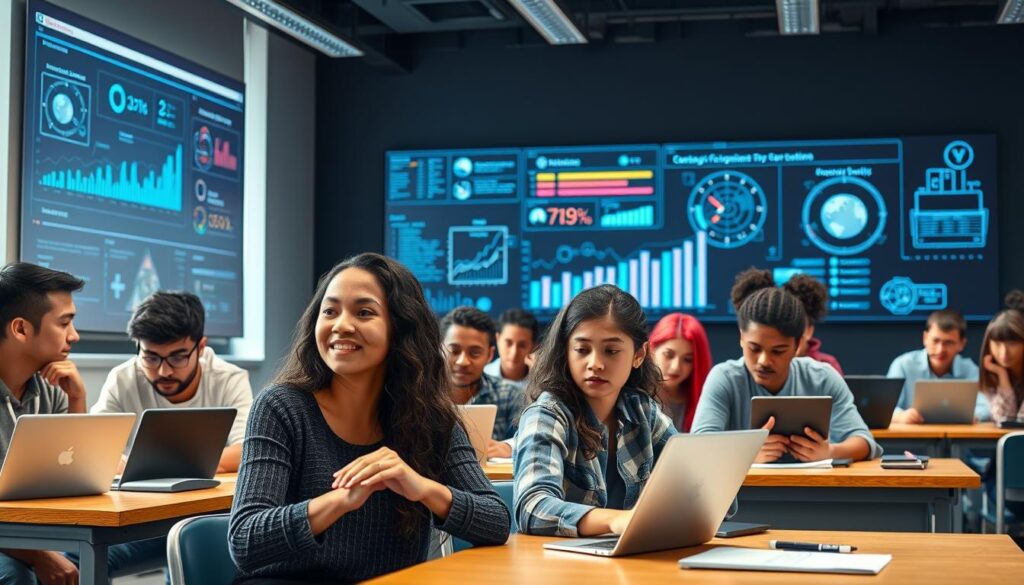
Conclusion: Embracing AI in Your Educational Journey
AI is changing education in big ways. It’s important to take steps to use AI in your teaching. By adding AI tools to your classroom, you can make learning more personal and effective for your students. AI can even help students succeed up to 30% more in different subjects22.
Creating a culture that values innovation and digital skills is also key. This helps teachers keep up with new tech in education.
Steps for Educators and Institutions
Start by looking for chances to learn more about AI and tech skills23. This will help you work better with your colleagues. It also helps you teach students to use tech wisely.
By focusing on critical thinking, you prepare students for a tech-savvy future. Taking these steps will make you and your school ready for what’s next.
Resources for Further Exploration
There are many resources for teachers to learn about AI in education. Reading research, going to workshops, and joining online discussions can help a lot. These steps can lead to more personalized learning and better student engagement22.
With hard work and the right tools, you can help make education more inclusive and fair for everyone.
FAQ
What is AI in education?
How does machine learning differ from traditional learning methods?
What are intelligent tutoring systems?
What are the benefits of implementing AI in classrooms?
What challenges do educators face when integrating AI?
How can educators be trained to effectively use AI tools?
What does the future of education technology look like with AI integration?
How can the effectiveness of AI in education be measured?
Source Links
- The Role of AI in Shaping the Future of Education Industry – https://www.bytestechnolab.com/blog/role-of-ai-in-education-industry-future/
- AI education and AI in education – https://new.nsf.gov/science-matters/ai-education-ai-education
- Research Guides: Artificial Intelligence (AI) in Education: Home – https://guides.lib.jmu.edu/AI-in-education
- Reimagining the machine learning life cycle to improve educational outcomes of students – https://pmc.ncbi.nlm.nih.gov/articles/PMC9992853/
- Machine Learning in Education- Cloud Services for Education- AWS – https://aws.amazon.com/education/ml-in-education/
- Learning With AI, Learning About AI – https://www.cde.ca.gov/ci/pl/aiincalifornia.asp
- AI in education: Use cases, solution and implementation – https://www.leewayhertz.com/ai-use-cases-in-education/
- AI Will Transform Teaching and Learning. Let’s Get it Right. – https://hai.stanford.edu/news/ai-will-transform-teaching-and-learning-lets-get-it-right
- 5 Pros and Cons of AI in the Education Sector – https://www.waldenu.edu/programs/education/resource/five-pros-and-cons-of-ai-in-the-education-sector
- Artificial intelligence in education: Addressing ethical challenges in K-12 settings – https://pmc.ncbi.nlm.nih.gov/articles/PMC8455229/
- 43 Examples of Artificial Intelligence in Education – https://onlinedegrees.sandiego.edu/artificial-intelligence-education/
- How Is AI Used In Education — Real World Examples Of Today And A Peek Into The Future | Bernard Marr – https://bernardmarr.com/how-is-ai-used-in-education-real-world-examples-of-today-and-a-peek-into-the-future/
- AI in Education: Benefits, Use Cases, Challenges, Cost & More – https://appinventiv.com/blog/artificial-intelligence-in-education/
- The Future of Education: Integrating AI and Machine Learning in Curriculum – https://www.linkedin.com/pulse/future-education-integrating-ai-machine-learning-curriculum-rohit-bag-egf5f
- Artificial Intelligence and the Future of Teaching and Learning: What You Need to Know – https://www.panoramaed.com/blog/ai-future-teaching-report
- Education and Artificial Intelligence: Navigating the Path to Transformation – EdSurge News – https://www.edsurge.com/news/2023-12-18-education-and-artificial-intelligence-navigating-the-path-to-transformation
- Effective Professional Development on AI – https://www.edutopia.org/article/ai-professional-development-helps-teachers-tech-integration/
- 7 Strategies to Prepare Educators to Teach With AI – https://www.edweek.org/technology/7-strategies-to-prepare-educators-to-teach-with-ai/2023/06
- AI Impact on Education: Its Effect on Teaching and Student Success – https://www.netguru.com/blog/ai-in-education
- How is AI impacting the education system? – https://keymakr.com/blog/how-ai-is-impacting-on-the-education-system/
- Can AI transform education? – https://www.gatesfoundation.org/ideas/articles/ai-tools-education-technology
- AI in Education: Transforming the Education Sector – https://hashstudioz.com/blog/ai-transforming-education-sector/
- Embracing the future of Artificial Intelligence in the classroom: the relevance of AI literacy, prompt engineering, and critical thinking in modern education – International Journal of Educational Technology in Higher Education – https://educationaltechnologyjournal.springeropen.com/articles/10.1186/s41239-024-00448-3


